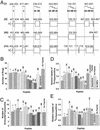Band 3 is a host receptor binding merozoite surface protein 1 during the Plasmodium falciparum invasion of erythrocytes
- PMID: 12692305
- PMCID: PMC154316
- DOI: 10.1073/pnas.0834959100
Band 3 is a host receptor binding merozoite surface protein 1 during the Plasmodium falciparum invasion of erythrocytes
Erratum in
- Proc Natl Acad Sci U S A. 2003 Sep 16;100(19):11184
Abstract
We report the molecular identification of a sialic acid-independent host-parasite interaction in the Plasmodium falciparum malaria parasite invasion of RBCs. Two nonglycosylated exofacial regions of human band 3 in the RBC membrane were identified as a crucial host receptor binding the C-terminal processing products of merozoite surface protein 1 (MSP1). Peptides derived from the receptor region of band 3 inhibited the invasion of RBCs by P. falciparum. A major segment of the band 3 receptor (5ABC) bound to native MSP1(42) and blocked the interaction of native MSP1(42) with intact RBCs in vitro. Recombinant MSP1(19) (the C-terminal domain of MSP1(42)) bound to 5ABC as well as RBCs. The binding of both native MSP1(42) and recombinant MSP1(19) was not affected by the neuraminidase treatment of RBCs, but sensitive to chymotrypsin treatment. In addition, recombinant MSP1(38) showed similar interactions with the band 3 receptor and RBCs, although the interaction was relatively weak. These findings suggest that the chymotrypsin-sensitive MSP1-band 3 interaction plays a role in a sialic acid-independent invasion pathway and reveal the function of MSP1 in the Plasmodium invasion of RBCs.
Figures




References
Publication types
MeSH terms
Substances
Associated data
- Actions
- Actions
Grants and funding
LinkOut - more resources
Full Text Sources
Molecular Biology Databases
Research Materials

